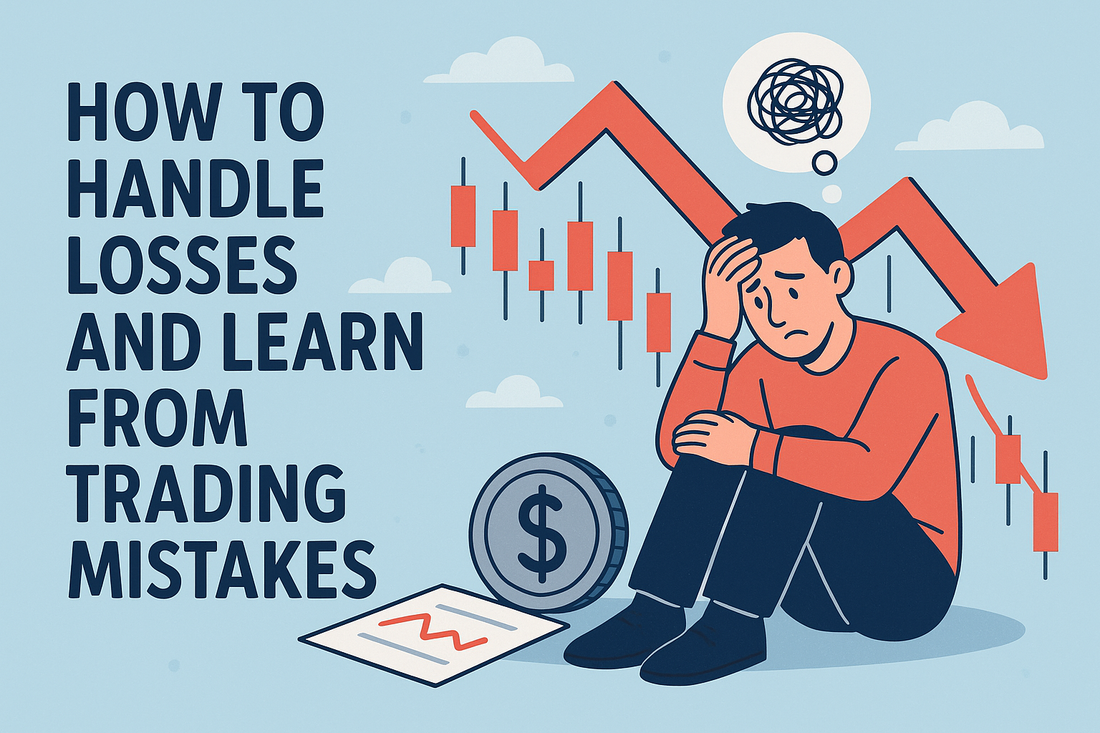
How to Handle Losses and Learn from Trading Mistakes: A Self-Sufficient Trader’s Guide
Keywords: handling trading losses, options trading mistakes, trade review process, trading discipline, emotional control in trading, learning from losing trades
💡 Introduction: Losses Are Part of the Game—But So Is Growth
No trader—no matter how experienced—is immune to losses. Yet the difference between amateurs and professionals isn't who wins more often, but how they respond to losses. For aspiring options traders pursuing financial freedom and self-sufficiency, the ability to manage mistakes, control emotions, and extract lessons is non-negotiable.
Losses hurt. But they’re also the greatest teachers in the markets. When handled correctly, a losing trade can become more valuable than a winning one—because it reveals something about your strategy, your mindset, or your process that needs to be optimized.
This guide offers a full framework for handling trading losses, reviewing mistakes, and turning every setback into a stepping stone toward long-term success.
🧠 Section 1: Psychological Insights – The Trader’s Mindset Around Losses
📉 Why Losses Feel Worse Than Wins
Behavioral economics teaches us about loss aversion—a cognitive bias where losing $100 feels more painful than the joy of gaining $100.
In trading, this manifests as:
- Cutting winners too soon
- Letting losers run
- Avoiding the journal
- Revenge trading
📌 Mindset Shift: You’re not losing money—you’re paying tuition to the market. The market teaches; your job is to extract the lesson.
⚠️ The 5 Emotional Stages of a Losing Trade
- Denial – “It’ll come back.”
- Frustration – “Why does this always happen to me?”
- Blame – “The market makers manipulated this.”
- Shame – “I’m not cut out for this.”
- Growth – “Let me figure out what I missed and adjust.”
👉 You want to shorten stages 1–4 and fast-track to stage 5.
🧘 Techniques to Stay Calm During Losses
- Breathing techniques: Box breathing (4-4-4-4) to reset your mind
- Stepping away: Take a walk before making another decision
- Visualization: Replay your trade as a coach would—not a critic
- Journaling emotions: Label what you felt and why
📌 Discipline isn’t emotionless—it’s the ability to manage emotion constructively.
🔍 Section 2: The Art of Reviewing Trades
📝 Why Reviewing Trades Matters More Than Placing Them
Winning trades feel good, but losing trades contain all the data that leads to improvement.
📌 Imagine improving just 1% with every review—you’d outperform most traders within a year.
🔧 Components of a Trade Review
Create a structured review template with the following fields:
|
Field |
What to Document |
|
Trade Setup |
Strategy used (e.g., bull put spread) |
|
Entry Rationale |
Why did you enter? What conditions were present? |
|
Entry/Exit |
Date, price, size |
|
Outcome |
Win/loss, P/L, duration |
|
What Went Right |
Even in a loss, what did you do well? |
|
What Went Wrong |
Mistake, misread, or execution error |
|
Adjustments |
What you’ll do differently next time |
📸 Include Visuals in Your Reviews
- Use TradingView screenshots
- Annotate entries, exits, key support/resistance
- Overlay with implied volatility (IV) when relevant
📌 Visual learners especially benefit from seeing patterns evolve.
📊 Tag and Categorize Your Mistakes
Example tags:
- “Entered too early”
- “Ignored IV crush”
- “No stop-loss”
- “Overleveraged”
This creates mistake frequency data that reveals your personal trading kryptonite.
📚 Section 3: Common Options Trading Mistakes (and How to Learn from Them)
❌ Mistake 1: Overtrading
Symptoms: Impulsive trades, FOMO, revenge trades
Lesson: Define a daily/weekly max trade limit. Focus on quality over quantity.
❌ Mistake 2: Ignoring the Greeks
Symptoms: Unexpected losses from theta decay, volatility crush
Lesson: Understand Delta (direction), Theta (time decay), Vega (volatility sensitivity), and Gamma (change in Delta).
❌ Mistake 3: Misjudging Implied Volatility
Symptoms: Buying straddles when IV is already high → no profit despite large move
Lesson: Always check IV Rank or IV Percentile. Sell premium when IV is high, buy when IV is low.
❌ Mistake 4: Overleveraging on Low Probability Trades
Symptoms: Going all-in on earnings plays or 0DTE gambles
Lesson: Keep position size consistent. Max 2–5% of account per trade.
❌ Mistake 5: Avoiding Stop-Losses or Adjustments
Symptoms: Watching a spread or naked option go to zero
Lesson: Predefine your exit rules. Use alerts. Practice rolling and adjusting in paper accounts.
🛠️ Section 4: Actionable Lessons and Growth Framework
✅ Build a Trade Recovery System
Every loss should activate a recovery checklist:
- Pause: Don’t trade again immediately
- Record: Log trade and journal emotions
- Review: Identify error and correctible behavior
- Simulate: Paper trade new version of setup
- Rebuild: Resume trading with reduced size
📈 Start a “Lessons Learned” Document
Every week, write down 1–2 lessons. These can include:
- “Don’t sell naked puts on earnings days.”
- “IV crush hurts long calls even when stock rises.”
- “Stick to breakouts only when price is above VWAP.”
Eventually, this becomes your trading Bible—custom-built by experience.
💬 Learn from Other Traders’ Mistakes
Join trading communities, follow mentors, and read trading books that include loss reviews.
Top resources:
- “Trading in the Zone” by Mark Douglas
- “The Daily Trading Coach” by Brett Steenbarger
- OptionStranglers live breakdown sessions
💡 Create a Personal Loss Management SOP
Sample structure:
- Max 2 losses per day
- Trade only if IV Rank > 50%
- Always define stop-loss at entry
- No trading during news events without predefined plan
- Weekly journal review every Sunday at 5PM
📊 Lessons Learned Chart
Visualize a horizontal list of trading lessons like:
Loss Event → Mistake → Insight → New Rule

Example:
|
Event |
Mistake |
Lesson |
Rule |
|
Sold naked put pre-earnings |
Misjudged IV |
Earnings are unpredictable |
Never sell options before earnings |
|
Bought long call in high IV |
Didn’t check IV |
Price rose, but lost money |
Don’t buy premium with IV Rank > 80 |
|
Let spread expire worthless |
No adjustment |
Roll would’ve saved capital |
Always review spreads 3 days before expiry |
💼 Section 5: Real Case Study – From Losing Streak to Systematic Success
Trader: Anwar, 38, Malaysia
Starting Capital: $7,000
Issue: Took 5 consecutive losses on long calls during earnings
Realization:
- Not tracking IV
- No trade journal
- Trading impulsively
Action:
- Paused live trading
- Did 1 month of paper trades
- Created a trade log with screenshots
- Added IV filters to setup
Result:
- Win rate increased from 41% to 62%
- Grew capital to $9,400 in 3 months
- Most importantly, he now trades without stress
🧠 Quote: “I learned more from my worst month than from any course.”
📘 Section 6: Use Tools to Strengthen the Feedback Loop
📓 Journaling Tools
- Notion – Build custom trade logs, mistake databases
- Edgewonk – Trading psychology & analytics
- Google Sheets – Fully customizable templates
📊 Analytics Tools
- OptionStrat – Simulate trade outcomes visually
- Tastytrade Platform – P/L graphs, trade history
- Thinkorswim – Analyze trade greeks and execution data
📈 Backtesting Tools
- OptionOmega – Strategy performance tracking over time
- QuantConnect – Algo-based backtesting (advanced users)
🧭 Final Word: Your Losses Are Your Competitive Edge
Losses don’t define your trading future—how you respond to them does. If you can face the market after a drawdown, reflect, and return stronger, you’re already ahead of 90% of traders.
Remember: even the world’s best hedge fund managers lose money. But they do three things better than the rest:
- They know exactly why they lost
- They use the data to improve
- They never stop learning
You have that power too.
🚀 Turn Your Losses Into Leverage
At www.optionstranglers.com.sg we offer:
✅ In-depth live 1-1 sessions / group classes
✅ Trade examples and breakdowns
✅ Community mentorship and support
👉 Ready to upgrade your strategy and trade like a pro?
Visit www.optionstranglers.com.sg and start your journey to financial freedom today.
Your future is an option. Choose wisely.
⚠️ Disclaimer:
Options involve risk and are not suitable for all investors. Always consult with a financial advisor before investing.
